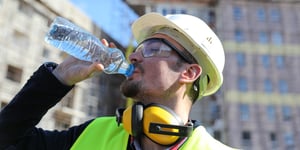 As the temperature continues to rise, so do heat-related illnesses among construction workers. The first step to minimizing your risk of these illnesses (and lowering your Contractor Insurance costs) is to understand potential illnesses, how to avoid them, and how to treat them.
As the temperature continues to rise, so do heat-related illnesses among construction workers. The first step to minimizing your risk of these illnesses (and lowering your Contractor Insurance costs) is to understand potential illnesses, how to avoid them, and how to treat them.
According to WebMD, "Heat exhaustion is strongly related to the heat index, which is a measurement of how hot you feel when the effects of relative humidity and air temperature are combined. A relative humidity of 60% or more hampers sweat evaporation, which hinders your body's ability to cool itself." A heat index of 90 degrees or more significantly increases the chance of a heat-related illness.
Certain factors can increase your risks of a heat-related illness, such as obesity, certain prescription medications, the use of illegal drugs, alcohol, and certain medical conditions, such as diabetes, kidney, and heart problems. Also, adults over 65 can be more susceptible to heat-related illnesses.
Here are four heat-related illnesses to look out for when you're working in hot and humid conditions – inside or out.
Heat Exhaustion
Heat exhaustion is the most common heat-related illness and can occur when a person is exposed to high temperatures for several days without adequate fluids.
There are two types of heat exhaustion – water depletion and salt depletion. Water depletion can cause excessive thirst, headache, weakness, and even a loss of consciousness. Salt depletion causes nausea, vomiting, dizziness, and muscle cramps. Additional symptoms can include confusion, dark urine, pale skin, rapid heartbeat, and profuse sweating.
If you or someone you're working with in hot and/or humid conditions experience these symptoms, the first step is to cool them down.
- Get them out of the heat – preferably into an air-conditioned room
- Remove tight or unnecessary clothing,
- Take a cool shower, bath, or sponge bath
- Drink plenty of fluids (including sports drinks, which replace salt)
- Remove tight or unnecessary clothing,
If these measures don't make you feel better within fifteen minutes, seek medical help. Without proper intervention, heat exhaustion can lead to heatstroke – a more serious heat-related illness that can cause damage to vital organs or even death.
Heat Stroke
Heatstroke is the most severe heat-related illness and, unlike heat exhaustion, requires immediate medical attention. According to the Centers for Disease Control and Prevention (CDC), "[Heat stroke] occurs when the body becomes unable to control its temperature: the body's temperature rises rapidly, the sweating mechanism fails, and the body is unable to cool down. Body temperature may rise to 106°F or higher within 10 to 15 minutes."
A person suffering from heatstroke will experience many of the same symptoms as heat exhaustion – headache, dizziness, nausea, etc. But a person with a heat stroke will stop sweating and have a high body temperature. As a result, their skin will be red, hot, and DRY rather than cold, pale, and clammy skin like someone with heat exhaustion.
If you see or feel any of these symptoms, immediately call for medical assistance, get out of the heat, and use any methods to cool down quickly (i.e., spray with cool water or immerse in a tub of cool water). Monitor the body temperature until it is below 103°F. Do not give fluids to someone with heatstroke.
Heat Cramps
When your body lacks both water and salt, your muscles can spasm and cause cramps, typically in the arms, legs, and abdomen. If you experience heat cramps, get out of the heat, drink cool water or electrolyte-replenishing drink, and apply a cool, wet compress to cramping areas. Seek medical assistance if the cramps don't go away within an hour of treatment.
Heat Rash
Heat Rash is the least serious heat-related illness, but it can be uncomfortable. It happens when sweat can't evaporate from the surface of your skin, which can happen to construction workers working long hours in hot conditions. With a heat rash, you'll see small itchy red bumps or blisters – typically on your chest, neck, groin area, and inside your elbow. You can help alleviate the symptoms by getting out of the heat and hydrating. A cool shower and the application of talcum powder can help eliminate the rash.
Here's How to Lower Your Contractor Insurance Costs
American Insuring Group wants to help lower your Contractor Insurance costs by helping you keep you and your employees safe. AND, as independent agents, we compare multiple competing insurance companies to ensure that you pay the lowest insurance premiums while providing you with great coverage.
Give us a call today at (800) 947-1270 or (610) 775-3848, or connect with us online.







